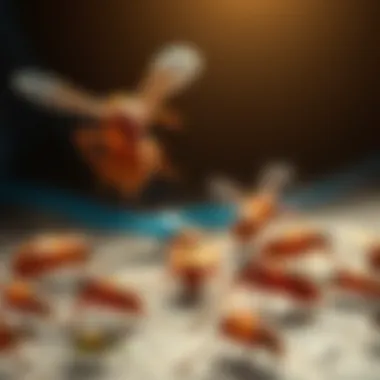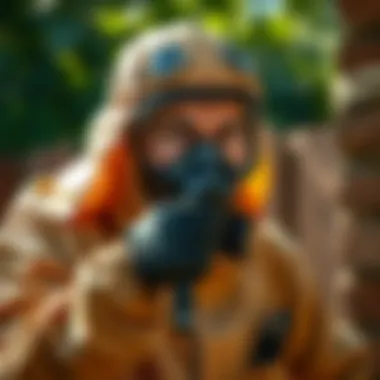Comprehensive Guide to Pronto Pest Control Methods


Intro
Pest control has become a crucial topic for households seeking to maintain a comfortable and healthy living environment. When pests invade, it’s not just a minor inconvenience; it’s a real threat to well-being. Pronto Pest Control stands out by offering tailored solutions for various pest problems. This guide dives deep into how Pronto Pest Control can assist in identifying, preventing, and treating pest infestations. It’s all about educating homeowners, renters, and even professionals on effective strategies to combat these nuisances.
Pest Identification
Understanding pests is the first step toward effective management. Identifying common pests that may take residence in your home can save time, money, and frustration. Here’s a closer look at various pests and their telltale signs.
Detailed descriptions of common pests
- Ants: These tiny soldiers often march in lines, searching for food. You might spot them near fruit, sugar, or crumbs. The two most prevalent types are the household and carpenter ants.
- Cockroaches: Known for their resilience, cockroaches are usually brown or black with a glossy exterior. They emit a musty odor and can often be found in dark, humid areas like kitchens and bathrooms.
- Termites: These wood eaters can be your home’s worst nightmare. If you detect hollow-sounding wood or mud tunnels on exterior walls, the presence of termites is a possibility.
- Bed Bugs: These small, reddish-brown insects thrive in bedding and upholstery. An itchy bite or small blood stains on sheets can indicate an infestation.
Signs and symptoms of infestations
Identifying an infestation early can make all the difference. Look out for:
- Droppings or sawdust-like material in corners
- Gnaw marks on furniture or walls
- Unexplained allergic reactions or sleepless nights
"Prevention and early detection can save you from costly treatments and stress in the long run."
Prevention Strategies
Taking preventive measures is often more effective — and less costly — than dealing with an infestation later.
Home maintenance tips for pest prevention
- Sealing cracks: Inspect doors, windows, and foundation for gaps. A little caulk or weather stripping can go a long way in keeping pests at bay.
- Proper sanitation: Regular cleaning, especially in kitchens and dining areas, minimizes food sources for potential pests. Don’t leave dirty dishes sitting in the sink!
- Managing moisture: Fix leaks and use dehumidifiers in damp areas. Most pests are attracted to moisture.
Natural deterrents and barriers
For those looking to keep pests away without resorting to chemicals, consider these natural deterrents:
- Essential oils, like peppermint or tea tree oil, can repel various pests with their strong scents.
- Diatomaceous earth: This natural powder can kill insects by damaging their exoskeleton. Sprinkle it in infested areas for effective results.
Treatment Options
When prevention fails, knowing treatment options become essential.
Overview of chemical vs. natural treatments
While chemical treatments have their advantages, such as immediate effects, they can also pose risks to humans and pets. On the other hand, natural treatments tend to be safer but may require more time to observe results. Consider the severity of the infestation when deciding the route to take.
Step-by-step guides for DIY treatments
- For Ants:
- For Bed Bugs:
- For Cockroaches:
- Mix equal parts vinegar and water. Spray on trails.
- Bait with sugar and borax to eliminate colonies.
- Wash infested linens in hot water and dry them on high heat.
- Vacuum thoroughly and consider using a steam cleaner on fabric-covered surfaces.
- Set up traps and baits.
- Mix baking soda and sugar; place around areas where roaches are spotted.
Understanding Pronto Pest Control
Understanding Pronto Pest Control is not merely about tackling a nuisance; it delves into the very heart of safeguarding our homes and environments from unwanted invaders. It’s crucial for homeowners to comprehend the breadth and depth of pest control methods available to them. This comprehension facilitates informed decisions, leading to choices that are not just effective but also eco-friendly and cost-efficient. Pest infestations can wreak havoc, causing damage and even health concerns. Thus, nurturing an understanding of pest management philosophies, like Pronto Pest Control, empowers individuals to act proactively rather than reactively.
Definition and Overview
Pronto Pest Control refers to a multifaceted approach within integrated pest management focusing on immediate and effective responses to pest issues. The term "Pronto" signifies swift action — getting to the root of pest problems quickly and efficiently. It encompasses a variety of methods ranging from preventive measures, like sealing entry points and eliminating standing water, to responsive strategies, such as targeted chemical applications or the introduction of natural predators.
The primary goal is to minimize harm to the environment while effectively controlling pest populations. Homeowners can adopt several strategies, such as regular inspections and maintenance of their living spaces, to curb potential infestations even before they occur. A multi-dimensional view of pest control, as advocated by Pronto, shifts the focus from simple eradication to sustainable management, fostering a healthier living environment. In essence, this methodology recognizes that understanding pest behavior and biology is fundamental in creating effective strategies for control.
History of Pest Control Methods
The history of pest control methods is as old as agriculture itself; it reflects humanity’s struggle against nature's relentless pursuit of balance. Early civilizations sought to protect their crops from pests by utilizing simple yet effective practices. For instance, Egyptians used antimicrobial substances like sulfur to deter pests, while the Romans innovated by employing traps and natural deterrents.
As society evolved, so did pest control techniques. The advent of synthetic pesticides in the mid-20th century represented a significant milestone, promising significant efficiency. However, over time, these methods raised concerns regarding health and environmental impacts leading to the rise of integrated pest management strategies, including biological control and organic solutions. Today, methods are typically tailored to balance immediacy with sustainability, crafted to suit the specific environments in which pests thrive.


Understanding this evolution is key for homeowners and pest control professionals alike. It's a reminder that while immediate solutions are necessary, long-term sustainability is equally critical in managing pest populations. When one knows the ebb and flow of pest control history, one is better equipped to navigate its present — and prepare for its future.
The Scope of Pronto Pest Control
Pronto Pest Control encompasses a wide array of services and solutions designed to manage pesky intruders that can disrupt the comfort of a home. Understanding the scope is essential for homeowners and renters alike, as it equips them with knowledge about which pests are commonly confronted and how to effectively handle potential infestations. By identifying and addressing specific pest concerns, individuals can safeguard their living spaces, avoid health risks, and maintain a pleasing environment.
Types of Pests Addressed
When discussing the scope of Pronto Pest Control, it’s crucial to shed light on the variety of pests that can invade residential spaces. These pests can be categorized into several groups, and each poses its unique challenges. Here are some notable types:
- Rodents: Among the most common culprits are mice and rats that not only cause property damage but can also carry diseases.
- Insects: This category is diverse and includes ants, cockroaches, termites, and bedbugs, all of which can severely impact hygiene and comfort.
- Wildlife: Occasionally, larger animals like raccoons or squirrels may invade urban and suburban homes, creating further complications.
- Garden Pests: Uninvited visitors like aphids and beetles can wreak havoc on gardens, affecting both aesthetics and food sources.
By recognizing the types of pests that Pronto Pest Control addresses, homeowners can better prepare for prevention strategies and response measures. Each type warrants specific approachment, ensuring that solutions are tailored to the distinctive behaviors and needs of the pests.
Common Infestation Scenarios
Infestations can occur under various circumstances, and understanding these can help in anticipating and mitigating issues before they escalate. Common scenarios include:
- Seasonal Changes: Many pests emerge during particular seasons—ants swarm in the spring, while rodents seek warmth in the winter. Knowing these patterns can lead to preemptive actions.
- Food Sources: Leftover food or improperly stored groceries can attract pests. Ensuring kitchens and dining areas are clean and clutter-free is vital.
- Moisture: Areas like basements and bathrooms that retain humidity often become hotspots for pests like termites and roaches.
- Entry Points: Many pests find their way indoors through tiny cracks or gaps in walls and foundations. Regular inspections to repair such openings can make a significant difference.
- Landscaping: Overgrown vegetation can provide hiding spots for pests like insects and rodents, enabling them to move closer to human habitats.
Understanding where and how infestations commonly occur allows homeowners to take proactive steps. Prevention is always more effective than treatment.
Principles of Effective Pest Management
Effective pest management is about more than just dealing with infestations after they occur. It involves a comprehensive approach that combines various methods to minimize pest problems before they become overwhelming. Understanding these principles can empower homeowners and renters to maintain a pest-free environment.
By grasping these concepts, individuals can protect their homes from damage and safeguard their health, all while being environmentally conscious. The ultimate goal is to create a harmonious living space, free from the disruption pests can cause.
Prevention Strategies
Prevention is the foundation of effective pest management. Implementing strategies that deter pests not only saves time and money but also provides peace of mind.
Home Maintenance Practices
Home maintenance practices play a critical role in pest control. This can include routine cleaning, sealing entry points, and regular inspections.
One of the key characteristics of home maintenance is its proactive nature. By conducting regular inspections, homeowners can catch potential pest issues before they escalate. This makes it a popular choice among savvy house owners who understand that an ounce of prevention is better than a pound of cure.
The unique feature of home maintenance practices is that they can be tailored to fit any home. Some might choose to invest in airtight containers for food storage, while others may focus on repairing leaky plumbing to eliminate water sources for pests. However, it’s important to note that home maintenance requires consistent effort. If neglected, the benefits may diminish, making it a task that needs regular attention.
Environmental Adjustments
Environmental adjustments refer to changes made in the living space that can deter pests. This might involve landscaping decisions, such as planting pest-repellent flora or altering outdoor lighting.
The key characteristic of environmental adjustments is their ability to leverage natural deterrents. Some homeowners choose this route because it's a more holistic approach that reduces reliance on chemical treatments. A notable advantage is that these adjustments can also enhance the aesthetic appeal of a property, offering a double benefit. However, adjustments might not yield immediate results, which can be frustrating for those looking for quick fixes.
Detection Techniques
Once prevention measures are in place, the next step is to ensure any potential issues are detected early. This is where detection techniques come into play, allowing homeowners to stay one step ahead.
Visual Inspections
Visual inspections are a straightforward yet effective method to detect pest issues. Through a close examination of areas where pests are likely to hide, such as basements, attics, and kitchens, homeowners can identify signs of infestation early.
One of the benefits of visual inspections is that they require no special tools or equipment, making them easily accessible for anyone. They are also a cost-effective strategy, especially for house owners who may want to minimize spending on pest control services. However, visual inspections can be limited in scope, as some pests may hide in hard-to-reach areas. This limitation can necessitate additional inspection methods to ensure thoroughness.
Use of Monitoring Tools
Monitoring tools can be invaluable in pest detection. From adhesive traps to electronic monitoring systems, these tools are designed to capture pest activity over time.
The primary advantage of using monitoring tools is their ability to provide ongoing surveillance. Homeowners who incorporate these into their pest management strategies can gain insights about when and where infestations might occur. Although they offer substantial benefits, it’s also important to recognize that monitoring tools come with costs and may require technical know-how for effective use. When deployed correctly, they can be a valuable asset in maintaining a pest-free home.
"Effective pest management is not merely about eradication; it's about prevention and maintaining a healthy environment for your family."
Overall, understanding and applying these principles of effective pest management sets the stage for a more proactive approach, turning the tide against unwanted invaders.
Chemical vs. Natural Solutions


In the world of pest control, the debate between chemical and natural solutions is paramount. Understanding the balance between these two can be a game changer for homeowners looking to effectively manage pest issues while ensuring the safety of their environment. Both solutions come with their unique benefits and drawbacks, and choosing between them often depends on factors like the type of pest, the severity of the infestation, and personal preferences regarding safety and environmental impact. Finding the right approach can mean the difference between a peaceful home and a constant battle against unwanted guests.
Overview of Chemical Treatments
Chemical treatments often include a range of products designed to eliminate pests quickly and effectively. These can include insecticides, rodenticides, and fungicides among others. Here's what you should know:
- Rapid Results: Chemical solutions tend to work instantly. When ticks or roaches invade your space, a chemical treatment can act like a fire hose, swiftly knocking down the problem.
- Variety of Options: Manufacturers continually innovate, providing treatments tailored for specific pests—be they ants, bedbugs, or termites. These options mean that homeowners can choose products designed for precise infestations.
- Reservation of Use: It's advisable to reserve these methods for really bad infestations or scenarios where less aggressive methods haven’t worked. Overuse can lead to resistance, making pests more resilient.
However, what’s equally important are the concerns:
- Health Risks: Prolonged exposure to chemical treatments may pose risks to children, pets, and even adults. Symptoms from mild irritations to long-term health issues can stem from misuse or overexposure.
- Environmental Impact: Chemical run-off can affect local ecosystems, harming plants and wildlife. It can be a slippery slope, impacting the very environment you're trying to protect.
Exploration of Natural Alternatives
Natural pest control solutions are gaining momentum among those seeking safer methods to combat pests. These alternatives can include everything from essential oils to diatomaceous earth. Here's a closer look:
- Safety First: Many natural remedies are safer for both the environment and human health. Ingredients like peppermint oil or vinegar can deter a variety of pests without the risk of chemical exposure.
- Sustainability: Using natural solutions means you’re also contributing to a greener planet. You'd be avoiding synthetic chemicals that might end up causing more harm in the long run.
- DIY Opportunities: One great perk of natural solutions is that many can be made at home. A simple mixture of soap and water can serve as an effective pesticide against soft-bodied insects.
Natural alternatives, however, come with their own set of challenges:
- Effectiveness Variance: Natural remedies may not provide instant relief. Patience is key; results can take longer when compared to chemical treatments.
- Applicability Limitations: Some serious infestations may require a more potent approach. When it comes to the harsh realities of certain pests, natural solutions may not always hold their ground.
Understanding your options—both chemical and natural—is crucial. Making an informed choice often leads to smarter pest management and a safer living space.
The Role of Professionals in Pest Control
When it comes to dealing with pests, the significance of professional intervention cannot be overstated. Many homeowners may think that pest control is straightforward – perhaps just a matter of setting traps or spraying some pesticides. However, the reality is often more complex. Pest management is not simply about eliminating pests but also involves a nuanced understanding of their behavior, habitat, and the potential impact of various control methods. This is where professionals shine.
Investing in expert services in pest control often leads to more effective and sustainable results compared to DIY methods. Trained specialists have access to advanced tools and have undergone rigorous training, making them adept at creating tailored pest management plans that suit your specific circumstances. In addition, pests can often return if not dealt with thoroughly. Professionals know how to address the root cause of an infestation, rather than just the symptoms.
When to Call a Pest Control Expert
Recognizing when it's time to call in the pros can save you a lot of time, money, and frustration. Here are some trigger situations:
- Persistent Infestations: If you've tried home remedies for an extended period and nothing seems to work, it’s a signal that you might need professional help.
- Health Concerns: Pests like rodents and cockroaches can pose serious health risks. If you suspect these invaders, it’s best to act quickly.
- Time Constraints: Many homeowners lead busy lives, making it hard to properly address pest issues. In such cases, hiring a pest control professional can be a necessity.
- Large Scale Infestations: If your home is under siege by swarms of insects or rodents, it’s undoubtedly a job for the specialists.
Keep in mind that the earlier an infestation is addressed, the easier it is to manage.
Qualifications of a Reliable Pest Control Specialist
Not all pest control providers are created equal. Here are a few key qualifications to consider when evaluating a pest control expert:
- Licensing and Certification: Always check if the pest control professional is licensed and certified. This is non-negotiable as it assures you that the specialist adheres to regulatory standards.
- Experience: Look for providers with a solid track record in the industry. Experienced professionals are usually better equipped to tackle diverse pest issues.
- Insurance: A reputable pest control company should have liability insurance. This protects you in case of accidents or damages during the treatment process.
- References and Reviews: Don’t shy away from asking for references or reading online reviews. Real customer experiences can give you valuable insights into the reliability and effectiveness of their services.
"A wise homeowner knows when to call the doctor for their pests. Ignoring a problem often just leads to bigger headaches."
Understanding when to contact a pest control expert and knowing what qualifies a reliable provider are crucial steps in effective pest management. With the right team in your corner, your pest problems can quickly become a thing of the past.
Understanding the Cost of Pest Control Services
The cost of pest control services often hangs as a shadow over the decision-making process for homeowners and renters alike. It is not just about investing money; it’s about securing a safe and clean living environment. By understanding costs in pest control, consumers can make informed decisions that prioritize both their health and their budget.
Why Understanding Cost Matters
The expense of pest management varies significantly, ranging from a few dollars for DIY solutions to potentially thousands for severe infestations requiring ongoing treatments. Being aware of potential costs helps homeowners plan appropriately, avoiding the financial sting that can accompany unexpected pest issues.
Factors Influencing Pricing
Numerous elements come into play when determining the pricing structure of pest control services. Here are a few key considerations:
- Type of Pest: Different pests require different approaches. For example, bed bugs can be more costly to eliminate than ants due to their complex life cycles.
- Infestation Severity: A light pest presence typically costs less to manage than an extensive infestation requiring multiple treatments.
- Property Size: Larger homes naturally will demand more resources, leading to higher costs.
- Treatment Method: Chemical treatments may vary in price compared to natural or preventative methods. Often, advanced methods, such as heat treatments, might draw a higher initial investment.
- Location: Prices can fluctuate based on geographical area, as certain regions may have higher demand for pest control specialists due to environmental factors.
When considering pest control, do not just look at the service fees; think also about the long-term value. Sometimes, a more expensive treatment upfront can save money in the long run if it effectively addresses the issue the first time.
"Quality pest control is not a cost; it is an investment in your home’s health."
Budgeting for Pest Control
Next comes the crucial aspect of budgeting. For homeowners, financial planning concerning pest control services can be a breath of fresh air amidst potential chaos. Knowing which services to prioritize can help in managing both expectations and expenses.
- Establishing a Baseline: Research local pest control pricing to know what to expect. Websites such as Angie's List or HomeAdvisor can provide insights into your local market.
- Emergency Funds: Set aside a portion of your budget for unexpected pest crises. Having an emergency fund for pest control prevents panic when unforeseen infestations occur.
- Preventative Maintenance: Consider investing in annual inspections or preventative measures. While these may incur upfront costs, they can save homeowners money over time by preventing more serious infestation scenarios.
- Explore Packages: Many pest control companies offer package deals for regular treatment. This could save a significant amount in the long haul.
- Insurance Considerations: Check whether your homeowner’s insurance covers pest control services; some policies do include pest-related damage, influencing the final out-of-pocket cost.
Understanding costs related to pest control not only consolidates your home’s safety but encourages responsible spending. Solid knowledge on pricing enables homeowners to effectively manage both nuisances and their finances.


Real-Life Case Studies
Real-life case studies play a pivotal role in understanding the practical implications of pest control methods, especially in the context of Pronto Pest Control. These instances serve as illustrative examples that shed light on the effectiveness of various strategies, offering real-world insights that can help homeowners navigate their concerns about pest management. When we analyze successful interventions or learn from the challenges faced in specific scenarios, it becomes clearer what works and what does not.
Each case study provides a narrative that can resonate with individuals experiencing similar pest problems. This relevance is crucial as it helps demystify pest control processes and showcase the manageable nature of these situations, making it less intimidating for homeowners. Moreover, gleaning lessons from these experiences can guide others in implementing their pest control measures safely and effectively.
Successful Interventions
A standout case occurred in a suburban neighborhood plagued by a sudden influx of termites. Homeowners were feeling overwhelmed by the potential damage these pests could inflict, not to mention the financial burden associated with extensive repairs. In response to this, a local Pronto Pest Control provider was called in to assess the situation.
The pest control team conducted an initial inspection, which revealed several entry points in the houses. Through a combination of direct pest treatments and wood treatments, the Pronto team took action swiftly with an integrated pest management approach.
- Treatment Steps Taken:
- The team started by applying a targeted chemical barrier around the property’s foundation to eliminate existing termites.
- They also recommended the removal of wood debris and moisture issues, which attracted termites, thus reinforcing long-term prevention.
Thanks to these methods, the intervention was deemed successful. The information collected during the inspection and treatment phases not only resolved the infestation but also educated homeowners about ongoing maintenance practices, effectively reducing the likelihood of recurrence.
Lessons Learned from Challenges
While many cases highlight success, it's equally valuable to analyze unfortunate outcomes to improve future pest control practices. One notable example involved a homeowner who attempted a DIY approach to tackle a wasp infestation in their attic. Despite having access to many online resources and store-bought solutions, the situation escalated rather than improved.
- Challenges Faced:
- The homeowner did not recognize the specific species of wasp, which resulted in using an ineffective spray that only angered the wasps.
- Moreover, without comprehensive knowledge of safety procedures, the homeowner personally attempted removal and suffered from multiple stings.
In hindsight, this case underscores the importance of professional interventions in certain situations. It also highlights that not all pest problems are suitable for DIY solutions. From this, homeowners learned that calling in experts like those from Pronto Pest Control could save them from dangerous encounters and unexpected costs.
Reflecting on these challenges emphasizes that sometimes, the best offense is a good defense; when in doubt, folks should lean on the knowledge of pest control professionals who can devise comprehensive, tailored solutions.
Future Trends in Pest Control Innovations
Exploring the future trends in pest control innovations is crucial as it reveals the trajectory of how we will manage pest-related challenges in our homes and neighborhoods. With ongoing advancements in technology and a growing awareness of environmental impacts, the pest control industry is shifting towards methods that are not only effective but also sustainable. Homeowners and renters alike need to stay informed about these trends to ensure they are utilizing the most efficient and humane practices available.
Emerging Technologies in Pest Management
Technology is fundamentally changing the way pest control is approached. New tools and methods are revolutionizing pest management in several ways:
- Smart Devices: From smart traps that send alerts when pests are detected to sensors that monitor pest activity, these devices enable homeowners to stay ahead of infestations. Imagine having a system that alerts you via your smartphone whenever a rodent is nearby—this is already happening in some high-tech homes.
- Drones: Drones are being utilized to survey large areas, especially for agricultural purposes where pests can quickly overwhelm crops. This aerial overview allows for more targeted treatment, reducing the need for widespread application of chemicals.
- Biotechnology: The field of biotechnology is also making inroads into pest control. Genetically modified organisms (GMOs) are increasingly being developed to be pest-resistant, leading to a drop in pesticide usage. This technology holds promise, especially in agricultural settings.
- Microbial Pest Control: Utilizing natural microbes to combat pest populations offers a non-chemical solution that poses less risk to beneficial insect populations, including pollinators. This approach is gaining traction as researchers discover new ways to deploy microbes effectively.
These technologies not only improve efficacy but also reduce environmental impact, making pest control more sustainable and in tune with modern ecological sensibilities.
Predictive Approaches for Pest Control
Looking forward, predictive analytics is shaping how pest control services strategize their efforts. Here's how:
- Data-Driven Insight: By analyzing historical data on pest outbreaks, experts can forecast potential infestations. For instance, if a region typically sees a spike in termite activity after certain weather patterns, pest management companies can prepare accordingly.
- Geographic Information Systems (GIS): GIS technology allows companies to visualize pest activity on a map, identifying hotspots and trends. This tool enables targeted interventions in areas most at risk, optimizing resource allocation and improving results.
- Artificial Intelligence (AI): AI algorithms analyze complex datasets to identify warning signs of pest activity at an early stage. This proactive approach minimizes damage and helps in planning timely interventions.
The blend of technology and predictive strategies not only enhances efficiency but also empowers homeowners with the knowledge to manage pest issues better.
"Staying ahead of the game in pest control is all about embracing innovation and utilizing new tools to create a pest-free environment."
As these trends unfold, homeowners should keep them in mind when considering pest management options, ensuring that they choose methods that are not just effective, but also align with modern standards for sustainability and safety.
For further reading, you may find useful information on pest control innovations at Wikipedia and Britannica. Regular updates and discussions can also be found on platforms like Reddit and social media pages dedicated to home improvement and pest management.
Finale and Key Takeaways
When it comes to tackling pest problems, understanding the whole process can make a world of difference. This guide offers insights into numerous pest control strategies, focusing on Pronto Pest Control, which has proven to be an effective method for managing pests in residential settings. The importance of this topic cannot be overstated, especially as pests become more resilient over time.
Summarizing Essential Insights
Throughout this article, we've navigated the complexities of pest control, drawing attention to various methods, importance of prevention, as well as the professional support available. Here are a few core insights:
- Diverse Pest Management Solutions: Pronto Pest Control embraces both chemical and natural solutions, providing flexibility in managing different pests effectively. Homeowners can choose methods that align with their personal preferences and safety concerns.
- Preventative Measures Are Key: It's always better to prevent than to cure. Regular home maintenance practices can drastically minimize the chances of infestations. For instance, sealing cracks and maintaining cleanliness around the home are small yet powerful steps.
- Professional Expertise Matters: Knowing when to call in the experts can save time and money in the long run. Not every situation calls for a DIY approach. Specialized knowledge ensures that the right methods are employed with the required finesse.
- Cost-Benefit Analysis: The investment in pest control can pay off significantly, preventing damages and health risks associated with infestations. Understanding the variables that influence pricing helps in making informed decisions regarding budgeting for these services.
"Effective pest control is not just about eliminating pests; it’s also about creating an environment where they can’t thrive."
Final Thoughts on Pest Control Strategies
In relaying the considerations above, one can draw the conclusion that effective pest control lies not just in reactionary measures, but also in proactive ones. With Pronto Pest Control as a viable option, embracing a combination of prevention, intervention, and continued education about pest behaviors empowers homeowners and renters. Additionally, recognizing the priority of aligning pest management strategies with one’s lifestyle is crucial.
Through discipline in maintenance and informed engagement with pest control methods, the chances of suffering a serious pest problem can swiftly be diminished. As discussed, understanding when to reach out for help, and which methods are most effective, can greatly ease the burden of any pest issues. As we look at pest control, it becomes apparent that informed choices lead to a pest-free living environment—one of peace and comfort in our own homes.
Beyond the specifics discussed, it’s always valuable to stay abreast of new developments in pest management, allowing for continuous improvement in one's approach. That is the crux of effective pest management today.



